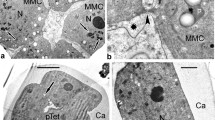Abstract
During microsporogenesis sporopollenin becomes accumulated independently by the only two sporopollenin-producing cell types in the higher plants—the anther tapetum and the microspores—not only within the exine, but also within the orbicules. In Spermatophytes usually only a single orbicule type is found, but sometimes, e.g., inEuphorbia palustris, two different types exist within a single species. Very interestingly, most orbicules are strikingly similar in their structure, sculpture, shape and dimension to the respective ektexine: e.g., smooth sporopollenin globules are found near the totally smooth exines ofEupomatia laurina andPentaphragma sinense respectively, while inDelonix elata andEuphorbia palustris the orbicules often look like some “incomplete” tectum pieces. All these parallelisms can be attributed to the homologous and therefore highly similar genetic information to form sporopollenin in the sporogeneous tissue and the anther tapetum. The orbicules should be seen neither as sporopollenin storage, as sporopollenin transfer vehicle, nor as sporopollenin surplus.
Similar content being viewed by others
References
Audran, J.-Cl., 1981: Pollen and tapetum development inCeratozamia mexicana (Cycadaceae): Sporal origin of the exinic sporopollenin in cycads. — Rev. Palaeobot. Palynol.33, 315–346.
—, 1981: Cytochemical and infrastructural aspects of pollen and tapetum ontogeny inSilene dioica (Caryophyllaceae). — Grana20, 65–80.
Bhandari, N. N., 1971: Embryology of theMagnoliales and comments on their relationships. — J. Arnold Arbor.52, 1–40.
Carniel, K., 1968: Licht- und elektronenmikroskopische Untersuchung der Ubischkörperentwicklung in der GattungOxalis. — Österr. Bot. Z.114, 490–501.
Cerceau-Larrival, M.-Th., & al., 1981: Relations sporophyte-gamétophyte: assise tapetale-pollen. — Ann. Sci. Naturelles, Botanique, 13e Serie,2 et3, 69–92.
Christensen, J. E., & al., 1972: Pollen wall and tapetal orbicular wall development inSorghum bicolor (Gramineae). — Amer. J. Bot.59, 43–58.
Dickinson, H. G., 1976: The deposition of acetolysis-resistant polymers during the formation of pollen. — Pollen & Spores18, 321–334.
Dunbar, A., 1973: Pollen development in theEleocharis palustris group (Cyperaceae), I. Ultrastructure and ontogeny. — Bot. Not.126, 197–254.
—, 1978: Pollen morphology and taxonomic position of the genusPentaphragma Wall. (Pentaphragmataceae). — Grana17, 141–147.
—, 1981: The preservation of soluble material on the surface and in cavities of the pollen wall ofCampanulaceae andPentaphragmataceae. — Micron12, 47–64.
Echlin, P., 1971: The role of the tapetum during microsporogenesis of Angiosperms. — InHeslop-Harrison, J., (Ed.): Pollen: Development and Physiology, 41–61. — London: Butterworths.
Hesse, M., 1979: Entwicklungsgeschichte und Ultrastruktur von Pollenkitt und Exine bei nahe verwandten entomo- und anemophilen Angiospermen:Polygonaceae. — Flora168, 558–577.
—, 1980: Ultrastruktur und Entwicklungsgeschichte des Pollenkitts vonEuphorbia cyparissias, E. palustris undMercurialis perennis. — Pl. Syst. Evol.135, 253–263.
—, 1985: Hemispheric surface elements of exine and orbicules inCalluna (Ericaceae). — Grana24, 93–98.
Lugardon, B., 1981: Les globules des Filicinées, homologues des corps d'Ubisch des Spermaphytes. — Pollen & Spores23, 93–124.
Nilsson, S., Robyns, A., 1974: Pollen morphology and taxonomy of the genusQuararibea s. l. (Bombacaceae). — Bull. Jard. Bot. Nat. Belg.44, 77–99.
Pacini, E., Juniper, B. E., 1979a: The ultrastructure of pollengrain development in the olive (Olea europaea). 1. Proteins in the pore. — New Phytol.83, 157–163.
—, —, 1979b: The ultrastructure of pollengrain development in the olive (Olea europaea). 2. Secretion by the tapetal cells. — New Phytol.83, 165–174.
—, 1985: The tapetum: its form, function, and possible phylogeny in Embryophyta. — Pl. Syst. Evol.149, 155–185.
Reznickova, S. A., Willemse, M. T. M., 1980: Formation of pollen in the anther ofLilium. II. The function of the surrounding tissues in the formation of pollen and pollen wall. — Acta Bot. Neerl.29, 141–156.
— & al., 1980: Investigation of exine and orbicule formation in theLilium anther by SEM. — Acta Bot. Neerl.29, 157–164.
Rowley, J. R., 1963: Ubisch body development inPoa annua. — Grana Palynol.4, 25–36.
—, 1974: Plasma-membrane glycocalyx origin of Ubisch body wall. — Pollen & Spores16, 441–448.
Taylor, T. N., Alvin, K. A., 1984: Ultrastructure and development of mesozoic pollen:Classopollis. — Amer. J. Botany71, 575–587.
Young, B. A., Schulz-Schaeffer, J., Carrol, T. W., 1979: Anther and pollen development in male-sterile intermediate wheatgrass plants derived from wheat × wheatgrass hybrids. — Canad. J. Botany57, 602–618.
Author information
Authors and Affiliations
Rights and permissions
About this article
Cite this article
Hesse, M. Orbicules and the ektexine are homologous sporopollenin concretions inSpermatophyta . Pl Syst Evol 153, 37–48 (1986). https://doi.org/10.1007/BF00989416
Received:
Issue Date:
DOI: https://doi.org/10.1007/BF00989416




